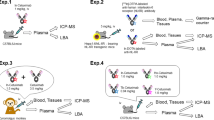Abstract
The effects of diethylene triamine penta-acetic acid (DTPA) on indium-111 monoclonal antibody (MoAb) metabolism were examined. Sequential analysis of 111In-MoAb incubated in serum at 37°C by high performance liquid chromatography (HPLC) and electrophoresis revealed that the radioactivity gradually moved from the MoAb to a 70–90 kDa molecular weight fraction. DTPA inhibited the transchelation of 111In to this fraction. It also decreased 111In uptake by isolated rat heptocytes but did not remove 111In incorporated in hepatocytes. The daily in vivo administration of DTPA (0.5–2.0 mg/mouse daily) to athymic mice after 111In-MoAb injection significantly reduced the 111In uptake in the liver and kidney. The tumour uptake was decreased somewhat but not significantly. The serum radioactivity in the 70–90 kDa fraction was also decreased. Scintigraphic examination demonstrated a decreased liver uptake in the DTPA-treated group of mice. Our results show that 111In released from the DTPA-MoAb conjugate in serum binds to molecules of 70–90 kDa and that DTPA decreases the 111In uptake in this fraction, which induces a decrease of 111In accmulation in normal tissues.
Similar content being viewed by others
References
Abdel-Nabi HH, Schwartz AN, Higano CS, Wechter DG, Unger MW (1987) Colorectal carcinoma: detection with indium-111 anticarcinoembryonic antigen monoclonal antibody ZCE-025. Radiology 164:617–621
Carrasquillo JA, Bunn PA, Keenan AM, Reynolds JC, Schroff RW, Foon KA, Ming-Hsu S, Gazdar AF, Mulshine JL, Oldham RK, Perentesis P, Horowitz M, Eddy J, James P, Larson SM (1986) Radioimmunodetection of cutaneous lymphoma with 111In-labeled T101 monoclonal antibody. N Engl J Med 315:673–680
Cole WA, DeNardo SJ, Meares CF (1986) Serum stability of 67CU chelate: comparison with 111In and 57Co. Int J Nucl Med Biol 13:363–368
Davidson SR, Boulos PB, Porter JB (1990) Inhibition of the hepatocyte uptake of radiolabelled monoclonal antibodies by chelating agents. Eur J Nucl Med 17:294–298
Deshpande SV, DeNardo SJ, Kukis DL, Moi MK, McCall MJ, DeNardo GL, Meares CF (1990a) Yttrium-90-labeled monoclonal antibody for therapy: labeling by a new macrocyclic bifunctional chelating agent. J Nucl Med 31:473–479
Deshpande SV, Subramanian R, McCall MJ, DeNardo SJ, DeNardo GL, Meares CF (1990b) Metabolism of indium chelates attached to monoclonal antibody: minimal transchelation of indium from benzyl-EDTA chelate in vitro. J Nucl Med 31:218–224
Fosburg MT, Nathan DG (1990) Treatment of Cooley's anemia. Blood 76:435–444
Hershko C (1975) A study of the chelating agent diethylene-triaminepentaacetic acid using selective radioiron probes of reticuloendothelial and parenchymal iron stores. J Lab Clin Med 85:913–921
Hird V, Stewart JSW, Snook D, Dhokia B, Coulter C, Lambert HE, Mason WP, Soutter WP, Epenetos AA (1990) Intraperitoneally administered 90Y-labelled monoclonal antibodies as a third line of treatment in ovarian cancer. A phase 1–2 trial: problems encountered and possible solutions. Br J Cancer 62 [Suppl X]:48–51
Hnatowich DJ (1986) Label stability in serum of four radionuclides on DTPA-coupled antibodies — an evaluation. Int J Nucl Med Biol 13:353–358
Hnatowich DJ, Childs RL, Lanteigne D, Najafi A (1983) The preparation of DTPA-coupled antibodies radiolabeled with metallic radionuclides: an improved method. J Immunol Meth 65:147–157
Jones PL, Brown BA, Sands H (1990) Uptake and metabolism of 111In-labeled monoclonal antibody B6.2 by the rat liver. Cancer Res 50 [Suppl]:852s-856s
Khaw BA, Gansow O, Brechbiel MW, O'Donnell SM, Nossiff N (1990) Use of isothiocyanatobenzyl-DTPA derivatized monoclonal antimyosin Fab for enhanced in vivo target localization. J Nucl Med 31:211–217
Kimura Y, Toki H, Okabe K, Suzuki K, Hayakawa T, Miyamoto K (1986) Establishment and characterization of a monocytic cell line which expresses the interleukin-2 receptor. Jpn J Cancer Res 77:862–865
Lockshin A, Stehlin JS (1987) Improved tumor localization of 111In labeled monoclonal antibody with chelator administration to host nude mice. Eur J Nucl Med 12:573–575
Murray JL, Rosenblum MG, Sobol RE, Bartholomew RM, Plager CE, Haynie TP, Jahns MF, Glenn HJ, Lamki L, Benjamin RS, Papadopoutos N, Boddie AW, Frincke JM, David GS, Carlo DJ, Hersh EM (1985) Radioimmunoimaging in malignant melanoma with 111In-labeled monoclonal antibody 96.5. Cancer Res 45:2376–2381
Norwood WD (1972) Plutonium (293Pu) toxicity diagnosis and therapy. J Occup Med 14:37–44
Paik CH, Herman DE, Eckelman WC (1980) Synthesis, plasma clearance and in vitro stability of protein containing a conjugated indium-111 chelate. J Radioanal Chem 57:553–564
Roselli M, Schlom J, Gansow OA, Raubitschek A, Mirzadeh S, Brechbiel MW, Colcher D (1989) Comparative biodistributions of yttrium- and indium-labeled monoclonal antibody B72.3 in athymic mice bearing human colon carcinoma xenografts. J Nucl Med 30:672–682
Rosenblum MG, Murray JL, Haynie TP, Glenn HJ, Jahns MF, Benjamin RS, Frincke JM, Carlo DJ, Hersh EM (1985) Pharmacokinetics of 111In-labeled anti-p97 monoclonal antibody in patients with metastatic malignant melanoma. Cancer Res 45:2382–2386
Sands H, Jones PL (1987) Methods for the study of the metabolism of radiolabeled monoclonal antibodies by liver and tumor. J Nucl Med 28:390–398
Seglen PO (1976) Preparation of isolated rat liver cells. Methods Cell Biol 13:29–83
Sharkey RM, Kaltovich F, Shih LB, Fand I, Govelitz G, Goldenberg DM (1988) Radioimmunotherapy of human colonic cancer xenografts with 99Y-labeled monoclonal antibodies to carcinoembryonic antigen. Cancer Res 48:3270–3275
Wagner SJ, Welch MJ (1979) Gallium-68 labeling of albumin and albumin microspheres. J Nucl Med 20:428–433
Ward MC, Roberts KR, Westwood JH (1986) The effect of chelating agents on the distribution of monoclonal antibodies in mice. J Nucl Med 27:1746–1750
Welch MJ, Welch TJ (1975) Solution chemistry of carrier free indium. In: Subramanian G, Rhodes BA, Cooper JF (eds) Radiopharmaceuticals. The Society of Nuclear Medicine, New York
Author information
Authors and Affiliations
Additional information
Offprint requests to: Y Kimura
Rights and permissions
About this article
Cite this article
Kimura, Y., Fujii, T., Ochi, K. et al. In vitro and in vivo effects of diethylene triamine penta-acetic acid on the distribution of indium-111 monoclonal antibody metabolism. Eur J Nucl Med 19, 759–764 (1992). https://doi.org/10.1007/BF00182816
Received:
Revised:
Issue Date:
DOI: https://doi.org/10.1007/BF00182816




